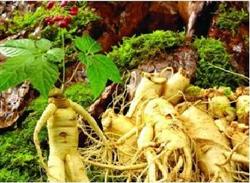Ginseng Blight and its Control

Rain Water is big this year, and the high temperature and humidity are very suitable for the reproduction of ginseng blight. The optimum temperature for the occurrence of ginseng blight is the soil temperature of 10: 30 ℃, the soil temperature of 20: 26 ℃ is the most suitable for the disease, and the disease will stop when the temperature is below 5 ℃ and above 30 ℃. The main pathogen of ginseng blight is caused by infection of Phytophthora cactorum (Leb.et Coh.) Schroet, a subphylum of flagella. Ginseng blight pathogen overwintered by hyphae and spores attached to the remains of diseased plants, soil and roots of diseased ginseng. The suitable period for the onset of the disease usually begins in June, and the peak period is the rainy season of high temperature and humidity from July to August. After occurrence, the harmful symptom to the aboveground plant was that there were brown water-immersed irregular disease spots on the base of the young stem or petiole at the initial stage of the affected plant, which rapidly expanded the whole compound leaf, resulting in the drooping leaves of the whole plant. The harmful symptoms to the underground ginseng root are yellowish brown water immersion, gradually expanding soft rot, the root bark is easy to peel off and give off a fishy smell, and the external white hyphae of the rotten root in the later stage, often with soil particles. The prevention and cure method is to pay attention to the ventilation of the shed and the drainage of the bed. Keep the bed well ventilated and drained, strengthen field management, and remove diseased plants to prevent the spread of bacteria. Quicklime or potassium permanganate 0.5% can be used at the acupoint. 1% solution for disinfection. Before the beginning of the rainy season, one spray of Bordeaux solution was sprayed, and then once every 7 to 10 days. You can choose 50% mancozeb 600 times, and spray 3 times 5 times depending on the condition. Or using these solutions to treat soil has a better effect.
- Prev

Field-to-home cultivation techniques of bamboo ginseng
(1) Cuttage is generally used for propagation. Cuttings with 5-7 leaves and about 15 cm of mature branches are cut into the sand bed. The row spacing is 4 cm × 10 cm. Keep the sand bed moist and grow roots for transplanting in about 20 days. It can be cut all year round, and it is easy to take root in spring and autumn. It is appropriate to choose a shady area as a seedbed in summer.
- Next

Control methods of ginseng grub
The grub is the larva of the big beetle. It is a gluttonous pest, which can endanger continuously. In general, the soil temperature of 10 cm in the surface layer of soil begins to move at 5 ℃ in spring, and the most suitable soil temperature is 13-18 ℃ on average. When it is higher than 23 ℃, it gradually transfers to the deep soil layer, and then moves to the upper soil when the soil temperature drops to its suitable active temperature in autumn. Daily life.
Related
- Fuxing push coffee new agricultural production and marketing class: lack of small-scale processing plants
- Jujube rice field leisure farm deep ploughing Yilan for five years to create a space for organic food and play
- Nongyu Farm-A trial of organic papaya for brave women with advanced technology
- Four points for attention in the prevention and control of diseases and insect pests of edible fungi
- How to add nutrient solution to Edible Fungi
- Is there any good way to control edible fungus mites?
- Open Inoculation Technology of Edible Fungi
- Is there any clever way to use fertilizer for edible fungus in winter?
- What agents are used to kill the pathogens of edible fungi in the mushroom shed?
- Rapid drying of Edible Fungi

